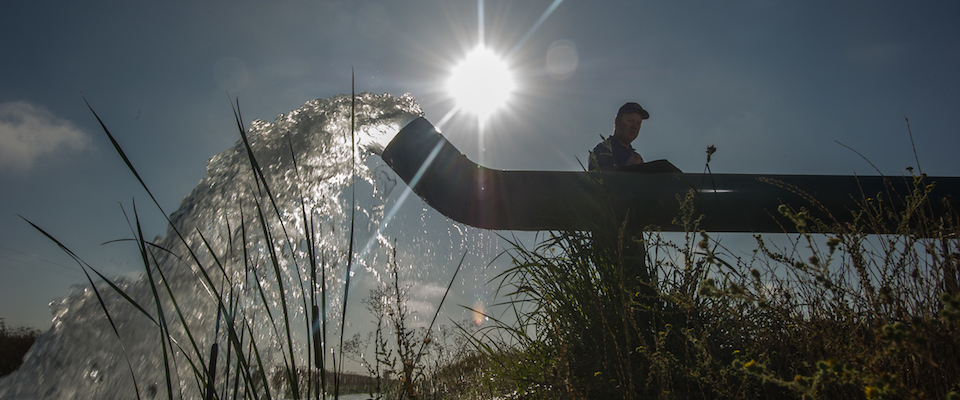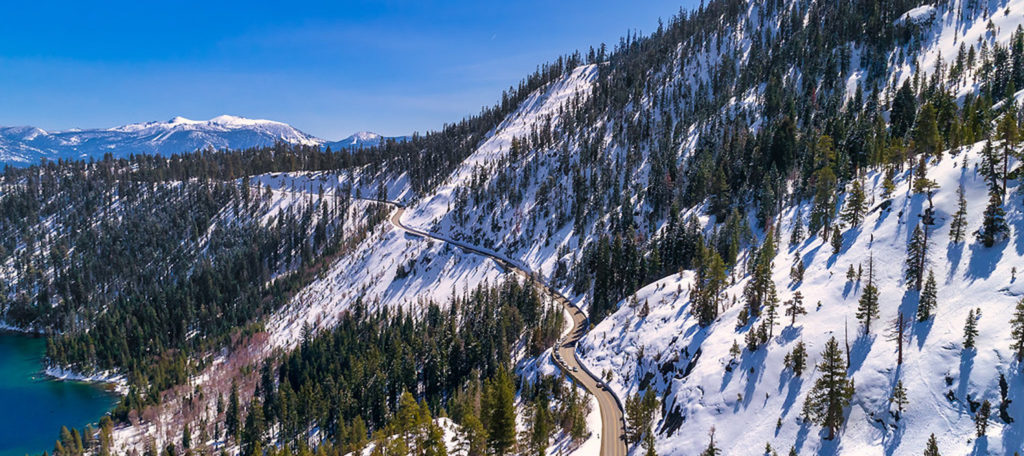It may not be a true meteorological “March Miracle,” but it’s close enough for government work, as government workers are wont to say. The series of storms that have battered California in recent weeks have pumped up the snowpack in the Sierra and swelled streams at lower elevations. And it looks like we could be in for a last wet gasp from the Pacific, with a fairly robust front poised to dump rain and snow mid-week. For a state that still teeters on drought despite last year’s extraordinarily wet rainy season, that’s good news.
Indeed, California’s reservoirs are mostly full, and it seems the state will get through the coming year without Draconian water restrictions. But both rainfall and snowpack remain below normal, and that’s a stark reminder that any relief in this semi-arid state is temporary at best. A dry spell could return at any time, and last as long—or longer—as the great drought of 2011-2017. And it’s clear that California’s water infrastructure is inadequate for such crises. There aren’t enough reservoirs in the state to slake the thirst of our cities and sprawling agricultural complex when the rainy season is anything but.
That has led, predictably, to a call for more reservoirs, particularly from Central Valley farmers. But virtually all of the rivers in the Sierra Nevada that can be dammed have been dammed. A scheme to add an extra dam to the upper San Joaquin River would cost billions and store about 1.26 million acre feet in the best of circumstances: insufficient for needs, say critics, given the cost and the likelihood that full capacity would be hit-and-miss. (One acre foot is equivalent to 326,000 gallons, enough water to sustain a family of four for a year.)
Another project, the “offstream” Sites Reservoir west of Colusa, would pump water from the Sacramento River during high flows and store it in a new, artificial lake. Total capacity would be about 1.8 million acre feet, but, again, costs would be extreme, the reservoir could only be filled during exceptionally wet winters, and much of the water would likely be lost from evaporation due to the reservoir’s low elevation and the torrid temperatures that characterize the Sacramento Valley for much of the year.
“Without regulation, there was no real incentive to manage sustainably. If you didn’t pump the water, somebody else would.”
Proposals also have been floated to dam the North State’s Eel and the Klamath Rivers, but environmental impacts would be extreme, costs would be stratospheric, and political opposition would be so fierce that any such project would be dead before the ink had dried on the proposed legislation. So what to do? California consumes between 45 to 50 million acre feet of water a year, and demand is rising. Where will it come from?
One thing is certain: short of constructing massive desalinization plants from Eureka to San Diego, we’re not going to “make” new water in any appreciable quantity. One way or the other, we’re going to have to manage the stuff that falls from the sky in a more judicious fashion. And the solution, it seems, is under our feet.
Subterranean aquifers, in fact, already are a significant source of water for California, contributing about a third of our annual supply. But until relatively recently, they were not managed to any real degree. Groundwater was pumped without any regard to supply or sustainability, and aquifers were routinely over-drafted as a consequence, causing massive ground subsidence in some areas. Parts of the San Joaquin Valley have slumped by as much as 20 feet due to excessive pumping.
“It was the tragedy of the commons,” says Cal PhD Anita Milman, an associate professor in the Department of Environmental Conservation at the University of Massachusetts at Amherst. “Without regulation, there was no real incentive to manage sustainably. If you didn’t pump the water, somebody else would.”
The deficiencies of such a laissez faire approach became acutely apparent during the recent drought, when water levels in scores of aquifers tanked. In response, the state passed the Sustainable Groundwater Management Act (SGMA) in 2014, a three-bill package that attempts to impose a policy framework on California’s hundreds of groundwater basins. Expectations for the legislation were, frankly, low at the time of its passage. But in the ensuing four years optimism has grown somewhat, both for the act’s authority and the potential for developing groundwater as a reliable defense against drought.
“SGMA marks a major shift, not just for groundwater management, but for surface water systems and land use,” says Michael Kiparsky, the founding director of the Wheeler Water Institute at Berkeley’s Center for Law, Energy and the Environment. “It’s not an immediate fix. Changing water policy is like turning a supertanker, but with SGMA, at least the rudder is now being cranked. If we can pull it off successfully, it could have profound and positive impacts.”
A hydrological reality that has long been ignored in California water law: the connections between groundwater and surface streams.
SGMA requires local governments to establish “groundwater sustainability agencies,” or GSAs, for each groundwater basin in their jurisdictions. These can be existing agencies that are empowered to manage groundwater, or new agencies created expressly for such oversight. In either case, the mandate requires the creation of management plans that meet several benchmarks, including quantifying and monitoring the amount of groundwater in each basin and avoiding practices that could lead to land subsidence, seawater intrusion and reduced water quality.
SGMA stipulates such plans must be in place for basins that are in critical overdraft by 2020 and for all basins that are at high to medium overdraft by 2022. Basins meeting those criteria now stand at well over 100. SGMA also has a backstop, with the state authorized to step in and enforce strictures if local authorities can’t or won’t meet the benchmarks.
“SGMA was designed to be flexible and geared for local control,” says Nell Green Nylen, a senior research fellow at the Wheeler Water Institute, “but the state backstop ensures compliance. If local agencies don’t create effective plans, the State Water Resources Control Board can consult with the Department of Water Resources, step in, put the basin on probation, and implement an interim plan that reduces pumping or requires recharge and replenishment of the aquifer, such as importing water from another source. Everything considered, though, the emphasis would probably be on the demand side—meeting sustainable yield by reducing pumping.”
SGMA also formally acknowledges a hydrological reality that has long been ignored in California water law: the connections between groundwater and surface streams. One of groundwater’s major attractions for irrigators says David Owen (J.D., Berkeley Law), a professor of law at UC Hastings, is that it was a kind of “regulation-free insurance.” It could be pumped without fear of legal consequences in regard to surface water impacts. But a recent court case involving the Scott River, a Klamath River tributary, confirmed such connections can exist, and SGMA further codifies this relationship. Thus, plans passed by GSAs may not be deemed truly sustainable by the state if they don’t address the impacts of pumping on surface sources; a dried-up stream, in other words, could be a red flag for the State Water Resources Control Board, with intervention likely.
This component of SGMA could lead to programs that could produce profound environmental benefits as well as improved groundwater levels, says Owen, including the creation of set-back berms along rivers that have long been straitjacketed between narrow levees. That would allow the rivers to meander in loops rather than running straight and fast, encouraging the percolation of water into underlying aquifers. Such wide river bottoms could also be managed for fish and wildlife habitat and recreational open space.
Kiparsky observes that groundwater basins might achieve sustainability through other replenishment methods such as “flood water for managed aquifer recharge,” or Flood-MAR.
Another opportunity for reclamation is urban wastewater—either storm water or sewage. And the resistance to drinking purified wastewater appears to be diminishing.
“It’s a state Department of Water Resources technique that takes advantage of the fact that California hydrology is highly variable,” says Kiparsky. “A lot of our precipitation comes in large events such as atmospheric river storms that cause major flooding. Historically, this replenished our groundwater when rivers were connected to aquifers, when they acted like sponges rather than pipes. So along with set-back berms, we can augment recharge by flooding agricultural fields in a targeted fashion—selecting those fields, say that have high rates of infiltration capacity and don’t have a lot of nitrate fertilizers or pesticides on them—pastures, hay fields or organic croplands, for example.”
Another opportunity for reclamation is urban wastewater—either storm water or sewage. Orange County already has made great strides in this area, recharging its aquifers with billions of gallons of purified wastewater annually.
“Capturing urban storm water would have two simultaneous benefits,” says Owen. “First, you’re securing water, a tremendous amount, really, that otherwise would be lost. Second, urban run-off typically has a lot of contaminants, so by capturing it and treating it before it hits bays or rivers, you’re reducing water pollution.”
But what about the “ick” factor—the disinclination to drink water that has been reclaimed from a sewer or storm drain? That appears to be diminishing, observes Owen.
“I just saw a headline,” Owen laughs. “A water agency tested reclaimed water against ‘natural’ water, and people preferred the taste of the reclaimed water.”
Owen emphasizes that the regulatory stick isn’t enough to insure compliance with SGMA, though in many cases, it may be that GSAs are confounded more by a lack of technical chops than malign intent or foot-dragging.
“The challenge is that most local departments don’t have groundwater modelers on staff,” Owen says. “They’re charged with first-line decision making, but they may lack the necessary expertise. [At Wheeler], we’ve looked at analogous programs in other states, such as land use or air quality, and the people we’ve talked to emphasized the importance of the state contributing skills and funding to local governments to achieve desired results. Compliance is crucial, but the state has to help with the technical side, it has to engage with locals on a deep level.”
These interactions won’t solve everything, emphasizes Owen. In fact, they may provoke spirited disagreement, but that’s essential to the development of sound policy.
“When you’re trying to define just what ‘sustainability’ is and how to measure it, you’re not going to have unanimity of opinion,” says Owen, “and to think you’re going to neatly solve every problem is unrealistic. It’s more rational to develop institutional relationships that allow meaningful discourse and progress toward functional policy. And it’s here that organizations like the Wheeler Center and university agricultural extension programs such as we have at Berkeley and Davis can help. We typically work at a more conceptual level, but we can also bring a lot of expertise to bear in these kinds of situations.”
Ultimately, says Green Nylen, there are reasons for both optimism and skepticism in regard to SGMA. The act’s flexibility, she says, could work either for or against effective water management.
“A lot depends on the State Water Resources Control Board doing its job, providing adequate review and assistance, and intervening when plans aren’t adequate,” Green Nylen says. “The great challenge is that California water law developed in a way that put groundwater and surface water on two nonintersecting tracks. SGMA doesn’t change or determine water rights, but it does recognize the connections between groundwater and surface water, and that linkage will be key in determining if the two can be reconciled.”





















